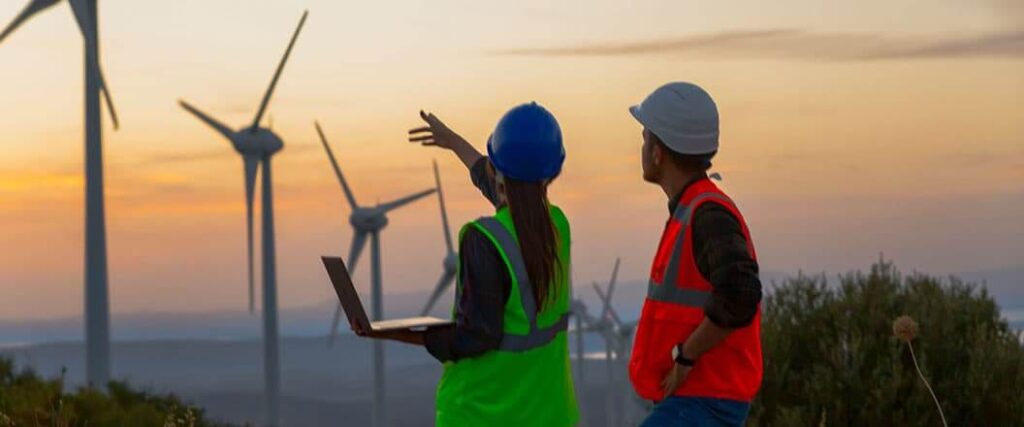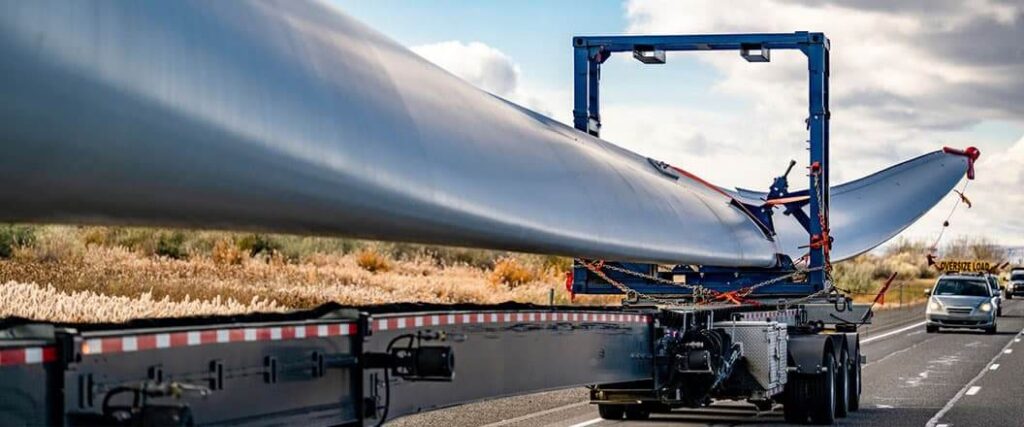Wind turbine transport is a service that’s extremely important to the renewable energy sector. Without it, wind farms wouldn’t be able to supply power to homes and businesses. While this service is important, there are many logistical challenges involved in the transportation of wind turbines and blades.
The logistics data provider Freight Waves acknowledges that wind turbine transport is difficult due its dimensions. Preparations like route planning and regulatory compliance must be completed for transport. When on the road, wind turbines and tower sections are separated into three sections and shipped on specialized trailers.
These are just the basics of wind turbine transport. There are many other factors that shippers will have to prepare for when organizing transport for these pieces of equipment.

Wind turbine transport is a service that’s used to ship wind turbines and other components that allow them to operate from one destination to the next. While this service is essential to the renewable wind energy industry, it’s costly and extremely time-consuming.
The reason wind turbine blade transport is costly and time-consuming is due to the size and weight of this type of freight. Wind turbines are extremely long, with many of them stretching 116 feet in length on average.
In some cases, wind turbine blades can be as long as 200 feet. Length isn’t the only reason wind turbines are considered oversized. They also exceed height requirements and have an average weight of 12 tons.
Despite these dimensions and weights, transporting wind turbine blades is a task that can be performed successfully with the right carrier and preparations.
Safety is of the utmost importance when it comes to transporting oversize freight like wind turbines. Unfortunately, there are many challenges that make wind turbine transportation difficult to perform safely.
Shippers and carriers should be aware of the following when moving this type of oversize equipment:
Before shipping a wind turbine, it’s important to understand what these challenges are so they can be prepared for accordingly.
The site conditions of a wind farm are one challenge that wind turbine shipments face. Wind farms are usually located on mountains and open rural areas with plenty of wind to harvest. Since wind farms are located in such remote areas, the access roads leading to them are usually gravel.
While gravel roads can easily support regular vehicles like service trucks, they’re not great for supporting wind turbines. The weight of the wind turbines can cause trucks carrying them to be bogged down on these roads. Even trucks transporting other wind turbine components like tower sections can be at risk as well.
Routes are always a point of concern when it comes to transporting oversize goods. That’s because oversize freight shipments need to travel on roads that can accommodate their extreme dimensions. Roads that have potential obstructions, like railroad underpasses and tunnels, should be avoided.
Another factor that has to be considered is that wind farms are usually located far away from major highways.

Finding reliable carriers for wind turbine transport is tedious on your own. Get a personalized quote from our industry experts.
That means wind turbine shipments need to travel on the following types of roads to get to their destination:
Roads like these can make transporting wind turbines especially dangerous. Therefore, thorough route planning must be completed to ensure the safe arrival of the shipment.
One challenge that specifically impacts shippers is the availability of carriers that are able to perform wind turbine transportation. Wind energy is growing in the U.S. and is likely to continue to grow in the future.
| Year | Wind Power Capacity In Megawatts |
| 2017 | 89,078 MW |
| 2018 | 96,487 MW |
| 2019 | 105,583 MW |
| 2020 | 122,465 MW |
| 2021 | 139,635 MW |
Provided by WINDExchange
As wind energy in the U.S. continues to expand across the country, the demand for carriers that are able to transport turbines to wind farms will increase. Another reason why shippers will have trouble finding transport is that not all oversize carriers will have the necessary equipment. Wind turbines need to be transported on specialized trailers rather than one of the many common flatbed varieties.
The last reason that finding wind turbine transport is difficult for shippers is due to a truck driver shortage. This means that carriers have fewer truckers at their disposal and won’t be able to book as many loads.

A few different types of vehicles and equipment allow carriers to transport wind turbines and the tower sections accompanying them safely to a wind farm.
The following types of equipment include:
Despite the extremely large size of wind turbines, a specialized truck isn’t needed to transport them. Regular semi trucks used for shipping other kinds of goods can also be used to move wind turbines and turbine tower sections.
Depending on the state the wind turbine is traveling through, escort vehicle services might be required. If that’s the case, then a turbine shipment is likely to be accompanied by one or two escort vehicles. The trailers used for wind turbine transport are unique compared to the more common varieties of flatbed trailers.
What makes these trailers unique is the length of each:
Schnabel trailers are around 45 feet in length and are used to transport the tower sections of a wind turbine. While this trailer is shorter than some of the more common varieties of flatbed trailers, Schnabel trailers have a special design feature that allows them to hold long pieces of freight. When in use, Schnabel trailers can be separated into two ends.
Each end has hydraulic rams and latching systems that allow it to hold a freight shipment in between them. The ends also lift the freight slightly above the ground which helps with clearing overhead obstructions.
Stretch and telescopic trailers have their own special features as well. These trailer types can extend and retract, allowing carriers to manipulate the length of the trailers based on the freight they need to move.

Given all the challenges and equipment needed to transport wind turbines from one destination to the next, preparing a wind turbine shipment requires precise planning. Most wind turbine shipments take an entire year to plan out due to all of the logistical and legal preparations that must be made for a shipment.
Picking a route for a wind turbine shipment to travel is even more tedious than it would be for other types of oversize cargo transportation. In most cases, only one route will be safe enough for wind turbines to travel on. Even then, the route that is chosen must be modified to make transportation safer.
Some of the modifications that have to be made are:
Since changes to public roads have to be made for wind turbines to safely traverse them, communication with the following officials is important:
Communicating with the correct authorities and performing the necessary modifications contributes to the time-consuming transportation planning process.

Reach out to us at (855) 490-2433 or fill out our quick form and a live agent will be in touch shortly.
Wind turbines are classified as oversized freight. Therefore, shippers and carriers will need to complete various regulatory protocols to transport turbines and tower sections to a wind farm. If the shipment is crossing through multiple states, shippers and carriers will need to ensure that they follow the regulations for each state.
Every state varies in its regulations, but shippers and carriers can expect to follow regulatory practices regarding:
Not following oversize regulations can result in a wind turbine shipment being fined and even stopped. The safety of the truck driver and other motorists on the road can be put at risk as well. Our article on heavy haul shipping regulations will provide you with more details regarding this topic.
The final step of preparing a wind turbine shipment is the loading process. Loading wind turbines and the tower sections that go with them is extremely dangerous. Therefore, loading must be done as carefully as possible.
The loading process can be broken down into two parts:
Cranes and forklifts are used to lift and lower turbine components onto a trailer. Heavy components are lifted with a crane while forklifts handle the lighter components. Tower pieces won’t require either a crane or forklift to load them.
Instead, tower pieces are transported using Schnabel trailers which are capable of lifting the tower pieces. Stretch blade and telescopic trailers will carry the other components of a wind turbine. Freight loaded onto these trailers will need to be secured with straps and chains.
Most wind turbine shipments will require 10 trucks to transport all of its components. Since so many trucks are used to move wind turbines, the loading process will be repeated with the same amount of care for each component.
If you need to move construction equipment instead of a wind turbine, then check out our article on transporting construction equipment.
The cost to ship a wind turbine can vary based on the distance it has to travel and other logistical factors. For short-haul transport, shippers can expect to pay somewhere between $30,000 to $40,000. Long-haul transport services cost shippers somewhere around $100,000.
With the help of the right heavy haul freight broker, you might be able to negotiate slightly less expensive shipping costs.
Finding a reliable carrier for wind turbine transport can be tedious to do on your own. At Heavy Haul & Oversized, we remove that frustration by finding a carrier that can move your oversize freight for you. We have a network of numerous oversize carriers that can provide flatbed transport anywhere in the country.
No matter what oversize freight you need to move, our carriers will have you covered. If you’re ready to start shipping, fill out your quote above or call us at (855) 490-2433.
Heavy Haul and Oversized
315 NE 14th Street #4122
Ocala, FL 34470
This is Mark with American Pilot Cars 25 miles north of New Orleans. I have just perused your website and it is an excellent informational tool. I have been in the pilot escort business for over 20 years. There is another critical financial issue that I see you have missed. The operational cost to provide Pilot Cars required for most of the wind component deliveries. I would be happy to share my information with you for your customers and may be reached at 985-705-7957. Thanks